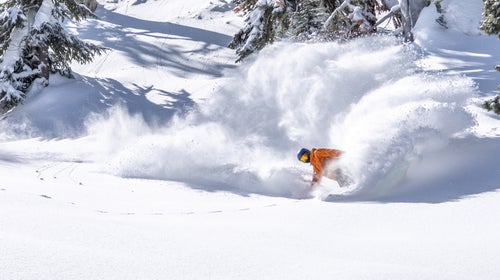Stoke was higher than usual at our annual snowboard test in Sugar Bowl, CA, this past spring—which is saying something. We attribute that off-the-Richter spike in excitement to several factors, including our biggest and best test squad ever assembled and a historic winter that caked the Sierra with roof-collapsing, cabin-burying, quadricep-cramping pow.
But the primary source of hype was no doubt the snowboards themselves. This year’s crop of decks was as stacked as Sugar Bowl’s spring snowpack—and that’s saying something, too. Submitted by brands big and boutique alike, boards range from park-slaying twins and all-mountain assassins to pow cruisers and big mountain blasters. But they all have one thing in common: they stoked the hell out of our test crew. We’re confident they’ll do the same for you.
The Winners at a Glance
- Lib Tech Apex Golden Orca (Editor’s Choice)
- Jones Hovercraft 2.0
- Rossignol Diva
- Stranda Biru
- Rome Stale Fish
- Yes the Pyzel Collab
- Capita Birds of a Feather
- Ride Deep Fake
- Burton Family Tree Short Stop
- Public Statement
- Gnu Barrett (2023 Editor’s Choice)
- Korua Transition Finder
- Yes Rival
- Academy Masters
- Burton Deep Daze
How We Test
Number of testers: 40
Snowboards tested: 57
Brands represented: 25
Average board score: 75.3 percent
Sugar Bowl’s snowfall for ’23 season: 809 inches
Most tree jibs in a single run: 9
AC joints separated: 1
Cases of fat tire remaining on day 4 of the test: 0
This year’s snowboard test was an early-April affair on the crown jewel of Tahoe’s Donner Summit: Sugar Bowl. The independently-owned resort offers the exceedingly rare combination of low-key liftlines and high-quality freeride terrain. We set up shop a snowball’s throw from the base of the Disney quad chair, which provided quick access to every type of terrain, from rippable groomers to spicy cliffs.
As we mentioned above, Sugar Bowl was hammered with storms all winter long, resulting in a historic snowpack of 809 inches. Our test window included a refresh storm that glazed the resort in powder—perfect for testing all-mountain and freeride shapes, while sunny skies throughout the week gave us shreddable slush, drool-inducing groomers, hot pow, and variable chop. Thanks to the plentiful snow, the park crew was able to sculpt a sweet spring park on Mt. Judah, and ski patrol opened up the puckering Palisades, a steep, spiny freeride zone oft compared to a miniature Alaska.
We had 40 testers in the mix—enough to handle 57 solid decks submitted by brands big and boutique alike. Riders made the pilgrimage from as far as Salt Lake City, but the vast majority of our test team consisted of local Tahoe riders who’d been enjoying the record-breaking winter for months on end. Skill sets ranged from intermediate to local-legend status—a critical mix to assess which boards are best for each specific skill level.
After hammering two or three laps on a board—occasionally more if the deck deserved it—testers returned to shredquarters to fill out comprehensive review forms. We scored boards on overall performance, responsiveness, turning ability, pop, and performance at speed. We had testers dive deep on flex, carving chops, and asked them if they’d spend their hard-earned cash on each board. Then, we grabbed a drill or screwdriver, found a new steed, swapped bindings, and hit the slopes. Rip, review, wrench, repeat.
We also ran extended testing throughout the rest of the season, seeking to put gear through as many conditions and scenarios as possible. Test veterans took select splits, solids, boots, bindings, and accessories on trips to Sweden, Japan, British Columbia, Utah, Wyoming, Nevada, and beyond. Finally, I (that’s me, Drew, our test director) sorted through over 300 feedback forms before identifying the top picks and writing these reviews.
Meet Our Lead Testers
Drew Zieff
Drew Zieff is a Tahoe-based freelance writer and a lifelong snowboarder. In addition to directing Outside Magazine’s snowboard and splitboard gear tests—a role he’s handled since 2016—he directs Backcountry Magazine’s splitboard test, waxes on the Natural Selection and snowboard culture for Whitelines Snowboarding, and nerds out on snowboard gear and travel for REI, Gear Junkie, Gear Patrol, and Popular Mechanics, among others. He spends his winters testing snowboard and splitboard gear in his backyard backcountry zones or up at Palisades, as well as chasing stories and storms to snowboard meccas like Alaska and Wyoming, British Columbia and Japan. His summers? They’re mainly spent at his desk, sifting through review forms and spec sheets, compiling our snowboard reviews—although he occasionally disappears in his custom-built 2006 Chevy Express for a few days when there’s swell on the coast.
Riley Bathurst
A Kiwi-transplant and first-year tester who calls Olympic Valley, CA, home, Riley Bathurst is a snowboard filmer and photographer whose work graces Palisades Tahoe’s Instagram and website. While Riley’s used to pointing the lens at other skiers and riders, he’s a remarkably talented and driven rider of his own right, too, and instantly made an impact on our test crew. Check out his latest work and adventures here.
Reviews: The Best Snowboards of 2024
Editor’s Choice: Lib Tech Apex Golden Orca ($1,299)
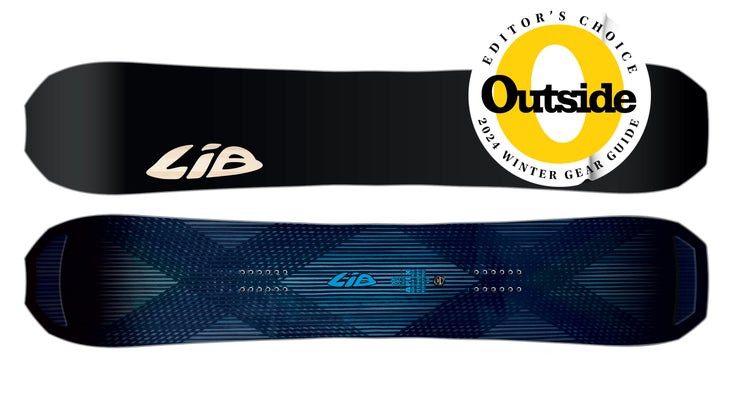
Sizing: 153, 157, 161 cm
Genre: Backcountry Freestyle/All-Mountain
Profile: C2X Directional, with mild camber in the rear foot, shortened rocker between the bindings, and aggressive camber in the nose.
Shape: Directional
Flex: 7/10
Waist Width: 26.5 cm (157 cm)
Sidecut: 8 m
Pros:
- This is the same proven shape as the Golden Orca, a board T. Rice has ridden down harrowing pillow fields, gnarly Alaskan faces, and en route to Natural Selection podiums
- Upgraded with a lightweight, futuristic core and carbon reinforcements, Lib’s Apex construction provides unreal response, snap, and stability at speed
- The cutaway, recessed nose and tail provide exceptional swing weight and maneuverability while the slightly volume-shifted shape retains float in deep snow
Cons:
- The price
- It’s not as damp in chop and chunder as heavier, carbon-free shapes
This year’s crop of boards was arguably the best submitted in the history of our snowboard test, yet awarding our Editor’s Choice honors was easier than ever. Why? Well, the Gnarwinian evolution of Travis Rice’s ever-popular Orca series has surely peaked with the debut of this year’s supercharged Apex Golden Orca. Six of nine testers gave this futuristic directional deck perfect scores—nearly 15 percent of the perfect scores awarded at this year’s test. This telling data sums up an airtime-annihilating, confidence-inspiring ride that approaches terrain like a killer whale toying with a blubbery seal before making it a meal. It’s equal parts fun and ferocious—one of those rare shapes that encourages advanced boarders to ride faster, go bigger, and spin when they might normally chicken out.
Much of the Apex Golden Orca’s all-mountain acumen comes from a shape it shares with the standard Golden Orca. First, the now-classic, wide, cutaway nose blasts through blower. The camber-rocker-camber profile, mid-wide, volume-shifted waist, and serrated sidecut that supply a perfect balance of pop, grip, and float. An extended, kinked tail rides switch better than the original Orca. But this pricier powder predator is lighter, more responsive, and more aggressive than the standard Golden Orca thanks to Lib Tech’s most advanced construction. Evolutionary enhancements include a lightweight yet snappy core crafted from aspen, paulownia, balsa, and recycled plastic bottles. A laminate layup of unidirectional carbon, carbon mesh, and magnesium techno fiber bands delivers springloaded power and surprisingly quick edge-to-edge action given the width, and a recessed, three-dimensional nose and tail provide minimal swing weight.
Lib’s technological alchemy strikes paydirt on- and off-piste. After local shop tech and no-holds-barred freerider Anthony Santos lapped Sugar Bowl’s iconic Palisades—a fin-featured spine zone reminiscent of Alaska—he affirmed that the Apex thrives in steep terrain. Santos complimented the Apex Golden Orca’s combo of Magne-traction (Lib’s signature serrated edges) and a mid-stiff flex pattern that supplies “excellent bite on icy steeps and eats up chunder and the competition.” Tahoe snowboard guide Andrew Allisandratos expressed testers’ thoughts on airtime well: “I felt like I could fly to the moon and stomp the landing as well. This might be the best board I’ve ever ridden.” A local pro accustomed to filming in no-fall-zone steeps and spinning off puckering cliffs summed it up: “Not much this board can’t handle.”
While positive feedback outweighed the negative, there were just a few critiques. One sidecut snob did find the serrated edges catchy on hardpack (if you’ve tried Magne-traction and you’re not a fan, keep that in mind), and the carbon craft isn’t as forgiving in chop as its damper, more affordable brother, the original Golden Orca. Otherwise, the few negatives were more warnings than anything else: this board isn’t for beginners or intermediates, and it performs best when ridden aggressively.
Bottom Line: By far the most coveted board of this year’s test, this responsive, lightweight all-terrain machine is a dream in steeps, powder, and in the air. It’s the key to unlocking peak performance on lines of a lifetime.
Jones Hovercraft 2.0 ($600)
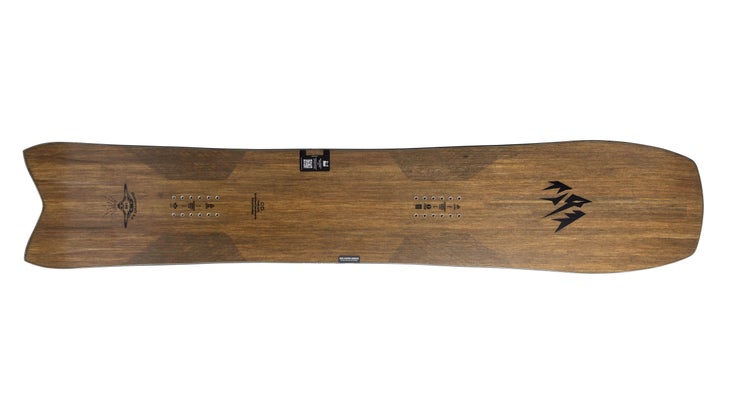
Sizing: 144, 148, 152, 156, 160, 164 cm
Genre: Alternative Freeride/Powder
Profile: Directional Rocker, with camber between the bindings
Shape: Directional
Flex: 7/10
Waist Width: 26.3 cm (156 cm)
Sidecut: 9 m (156 cm)
Pros:
- Same basic ingredients as the old Hovercraft, spiced up with a more aggressively contoured nose and three-dimensional tail for fluid, natural turns and glide in powder
- A versatile deep snow destroyer with an alternative freeride shape that can hack it as a daily driver
- Radical new stringers are derived from reclaimed snowboards, an exciting development for the eco-minded boarder
- New, inclusive unisex size run
Cons:
- The XXL nose can feel unwieldy in chop and tight trees for lighter riders or those with smaller boots
You’ll notice that Jones’ Hovercraft sports the spiffy “2.0” suffix for 2024, a rare honor bestowed only upon boards that have undergone serious re-design. The updated, now unisex shape retains the volume-shifted waist, lengthy sidecut, subtle, and stubby swallowtail that earned the original board a cult following (peep #ihearthovercrafting to observe ripping worshippers at play). The 2.0 designation is earned by drastic, three-dimensional changes to the nose and tail as well as an exciting, eco-friendly overhaul to the construction.
The spooned-out nose jumped from teaspoon to tablespoon, with Jones increasing the bevel of the concave shape from 7 millimeters to a whopping 12 millimeters, hoping to spark more synaptic turn initiation. The mission was a success according to tester Gela Malek Pour, a Mammoth freestyle coach who owns an older Hovercraft. “Turn initiation is effortless,” she reported after analyzing the board’s arcing acumen in powder, chop, and on manicured groomers. Tester John Lauer, a snowboard buyer for local shop, Tahoe Sports Hub, agreed, calling edge-to-edge action “so smooth. They nailed the positioning of the spoon tech.” Lauer also noted that the tail of the 2.0–which now sports an aggressively channeled hull for improved glide–seems more forgiving than the OG version, but still trustworthy on edge.
Tester Andrew Allisandratos, a splitboard guide for Blackbird Mountain Guides, appreciated the long, arc-swooping sidecut. “It shines laying carves and throwing slashes,” he said. However, there were a few testers, some lighter and with smaller boots, who felt outgunned by the width and stiffness of the nose, particularly when riding tracked-out zones or making tighter turns. “The Hovercraft will hover above any depth of powder and bite into a groomer of any firmness,” acknowledged one a ripping local lady, who was appreciative of Jones’ serrated traction tech along the sidecut. “It holds a solid edge–once you get there–but it needs a stern talking to in order to achieve small turns.”
And on the construction side? The Hovercraft 2.0’s sustainably sourced wood core is now reinforced by stringers sliced from reclaimed snowboards–a novel technique that makes this Jones the most eco-friendly option in their lineup so far. That makes this board a win-win option in our book.
Bottom Line: TheHovercraft 2.0 improves upon an old classic, amping up turning talents, float, and glide while adding a more eco-friendly engine under the hood.
Rossignol Diva ($600)
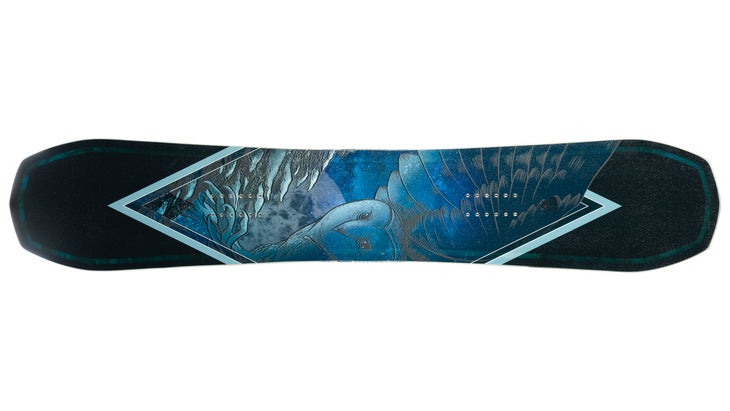
Sizing: 140, 144, 148, 152 cm
Genre: All-Mountain/All-Mountain Freestyle
Profile: Amptek Elite rocker-camber-rocker
Shape: Twin
Flex: 7/10
Waist Width: 24.2 cm (148 cm)
Sidecut: 4.6 – 6.4 – 7.3m (148 cm)
Pros:
- True twin shape is maneuverable and rides switch with grace
- Rockered nose and tail offer decent float in powder, especially when the stance is bumped back
- Semi-stiff core with dampening tech provides reliability at speed and a liveliness advanced female riders will appreciate
Cons:
- All-mountain freestylers and park riders may crave a more butter-friendly, jibby flex
- Not as floaty as more directional shapes on the deepest days
“Don’t let the name fool you–the Diva is an all-mountain weapon,” advised Anna Weber, a snowboard instructor examiner and Sugar Bowl passholder. She found the true twin to be an all-mountain asset that’s reliable on edge and stable at speed, traits that can be traced to the board’s construction. Inside, you’ll find a semi-stiff core reinforced with parallel basalt and kevlar strips and dampened by a urethane ribbon just inside the edges. Add to that a trustworthy camber shape underfoot and a hardpack-hammering serrated sidecut, and you’ve got yourself a board that likes to charge no matter the conditions. While the stiffness may be overkill for lightfooted intermediates, Weber did find enough edge-to-edge play for quick and effortless turn initiation. “Torsionally maneuverable through moguls,” agreed Tahoe fitness guru and snowboard coach, Nancy Brest, who also dug the Diva’s speedy sintered base, top-notch pop, and lightly rockered nose and tail for added float on deeper days. Testers agreed that the Diva was a solid do-it-all deck.“It handled high-speed groomers, post-pow-day chop, and sidehits, too,” summed up local rider Gretchen Stone. She recommended the board for “experienced riders who love all terrain and want a responsive, fun, stable board.” Weber did add one word of caution for all-mountain freestylers looking for a buttery jib stick: “The Diva can hang with the best of them on big jumps and cliff drops, but jibbing is not its strong suit.”
Stranda Biru ($690)

Sizing: 154, 157 cm
Genre: Alternative All-Mountain/Volume-Shifted Powder
Profile: Camber with early rise nose
Shape: Directional
Flex: 7/10
Waist Width: 27 cm (154 cm)
Sidecut: 6.7 m (154 cm)
Pros:
- Versatile, volume-shifted shape balances next-level float and agility
- Sidecut and camber provide locked-in, ultra-stable carves
- A unique shape from a boutique brand make this board a liftline conversation starter
Cons:
- Minimal size run
- Unwieldy for some lighter riders
The Biru is not your typical Swedish fish. A brawny, barrel-chested beast of a board from Stranda, a Scandinavian purveyor of premium powder craft and turning tools, this volume-shifted shape is designed to be ridden four-to-five centimeters smaller than your standard stick. And even after sizing down, you’ll still find the Biru an exceptionally confidence-inspiring ride thanks to its massive yet manageable nose, camber underfoot, gently serrated sidecut, and a reliable backbone of poplar, paulownia, and ash. “This board is the most stable thing I’ve ever ridden,” exclaimed Tahoe snowboard filmer Riley Bathurst.
For shop tech Anthony Santos, the Biru’s relatively long effective edge, stout tail, and goldilocks flex in the nose sparked a borderline religious experience on rail. “Perfect flex, stiff enough to handle speed but soft enough for slalom-like carves. The nose is a thing of beauty, God’s perfect mid-volume creation,” he proclaimed. While all testers agreed that the Biru supplies stability, float, and surfy slashes in spades, a handful of our lighter riders (those who weigh less than 160 pounds), wished for a smaller, more manageable size than the 154-centimeter length we had on tap at our test. Limited size run aside, the stoke was high for this versatile all-mountain ride.
Bottom Line: Featuring a striking, idiosyncratic shape from an on-the-rise Swedish board builder, the Biru is a bodacious, buoyant, stable, fun, and surprisingly versatile carving machine and powder pig.
Rome Stale Fish ($560)
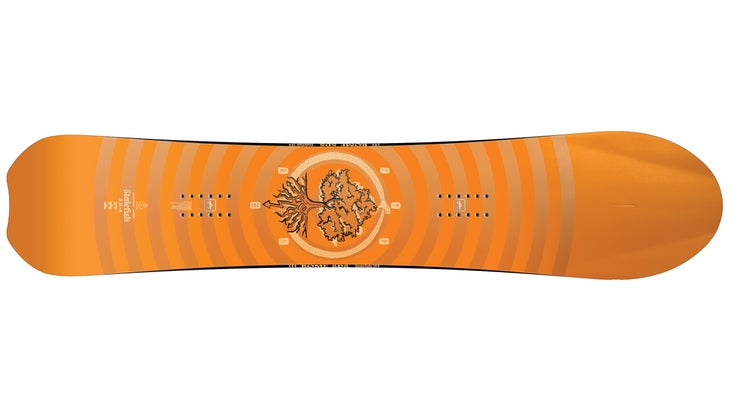
Sizing: 151, 154, 157, 160 cm
Genre: Alternative All-Mountain/Powder
Profile: Camber with rockered nose
Shape: Directional
Flex: 6/10
Waist Width: 26.7 cm (157 cm)
Sidecut: 6.6/7.9 m (157 cm)
Pros:
- New-and-improved shape handles all-mountain applications yet is still buoyant and fun in deep snow
- Crushes the carve game
- Surprisingly poppy and versatile
Cons:
- Some riders washed out exiting turns
- Nose is on the beefy side for lighter, surfier cruisers
There’s nothing stale about Norse all-mountain assassin Ståle Sandbech’s powder-pillaging Stale Fish. Rome revitalized the popular shape this year, rounding out the three-dimensional nose, adding a carbon rod to the schnoz for improved power, and reducing taper and setback. All told, the new shape seems more closely related to the Stale Crewzer, Ståle’s popular all-mountain directional twin, than in years past. Factor in last year’s tech update–dampening flax sidewall reinforcements that run from the front inserts to the nose–and the updated rig rips powder and piste to shreds.
“Holy shit, it can carve,” noted Outside Gear Director Will Taylor after arcing the Stale Fish down pitches of Sugar Bowl’s pristine corduroy, impressed by the sidecut’s fluid turning chops and the camber-heavy profile’s locked-in feel. When he piloted the Stale Fish onto untouched slopes, he was amped on the “instant float” provided by the wide, rockered nose. A hard-charging Utah firefighter, Jackson Weber, was similarly stoked. “Fast, responsive feel on both tight tree turns and wide, effortless, Euro carves,” he commented, calling the flex “perfection–stiff enough for chunder, snappy with a fun flex for heavenly butters.”
For some riders, the Stale Fish will be a quiver deck that can be deployed on deeper days, corduroy missions, and slush fests, but for others, the newly shaped ride and tweaked taper make it more versatile. “I’d be stoked to buy it and blast it every day. It’s got the best balance of any board I rode, even if other boards have it beat on certain aspects,” commented discerning gear nerd and Tahoe-based snowsports cinematographer, Riley Bathurst. Long test days can lead to leaden legs, and boards that aren’t up to snuff can subsequently lead to out-of-character falls. With that in mind, Bathurst gave the Stale Fish his highest compliment, calling it an “easy-to-ride, 4-PM hero.”
The only gripes: One all-mountain ripper did report washing out when exiting low-slung turns, and a slender rider found the stiffness of the carbon-backboned nose a bit beefy for lighter members of the surfy crowd.
Bottom Line: There are only a few boards our testers want underfoot for both first chair on a powder day and last chair on a spring slush afternoon. The Stale Fish is at the top of that shortlist.
Yes the Pyzel Collab ($600)
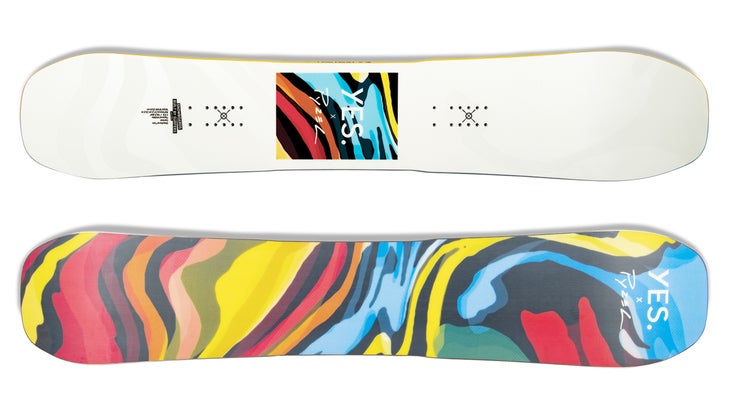
Sizing: 148, 150, 154, 155W, 158, 160W, 162, 164W cm
Genre: All-Mountain/All-Mountain Freestyle
Profile: Camber
Shape: Directional Twin
Flex: 7/10
Waist Width: 25.5 cm (158 cm)
Sidecut: 7.7 m (158 cm)
Pros:
- A surprisingly capable all-mountain ripper does exactly what you tell it to
- Approachable shape for intermediate riders
- One of our favorite topsheets of the test
Cons:
- Not remotely “surfy” if you’re looking for a surf-inspired shape
- Too soft for some harder chargers
“Surfy” is one of the most overused adjectives in all of snowboarding. And yet, the word serves a purpose, signifying snowboards that mimic the cruisy, easy-riding nature of their wave-riding cousins. When we learned that Yes was collaborating with John Pyzel, renowned surfboard shaper to arguably the best surfer alive, John John Florence, on a shape, we assumed the resulting snowboard would follow said surfy archetype. Instead, we were pleasantly surprised by how versatile the Pyzel is.
The Pyzel Collab is a mid-stiff, cambered charger that does exactly what you ask it to. It’s not remotely surfy–at least not how we snowboarders typically define the word. “If you were going to call it ‘surfy’ at all, I suppose it’s more similar to reliable thrusters ridden in heavy Hawaiian barrels than the twin-fin fish that cruise prosaic point breaks, ” voiced Tahoe-based test director Drew Zieff, who gravitated to the Pyzel as a daily driver thanks to the damp ride, poppy platform, and edge-hold and float provided by Yes’s proprietary Tapered Midbite tech. The latter is an indent in the sidecut between the bindings, essentially narrowing the waist while retaining a beefier nose and tail. The indent helps the Pyzel bite into hardpack, while the narrower waist increases nimbleness on rail, and the wider nose and tail boost float in powder and stability when stomping. “The indented sidecut ensured I never washed out,” acknowledged Zieff. Alec Tandara-Kuhns, a snowsports industry veteran and all-around ripper, agreed, calling the Pyzel a “great quiver killer that’s super comfortable turning and stable through all conditions.”
A couple of riders did find the flex on the soft side for the shape, with one heavier hard-charger recommending the deck more for intermediates than experts, noting “It allows a bit of progression but hits a ceiling pretty quickly.”
Bottom Line: Reliable on edge and easy to wrangle, the Pyzel is an unexpected collab that ride-anything intermediates and lighter, advanced all-mountain riders will be stoked to have as a central component to their quiver.
Capita Birds of a Feather ($550)

Sizing: 140, 142, 144, 146, 148, 148W, 150, 152, 152W, 154, 154W cm
Genre: All-Mountain Freestyle
Profile: Hybrid Camber
Shape: Twin
Flex: 5.5/10
Waist Width: 23.8 cm (148 cm)
Sidecut: 7.4 m (148 cm)
Pros:
- A tried-and-true all-mountain twin that crushes in and out of the park
- Approachable flex and familiar ride feel make it a smart pick for progression
- Solid jib companion
Cons:
- You won’t be breaking any land-speed records
- Too soft for no-holds-barred all-mountain chargers and freeriders
A women’s specific version of Capita’s best-selling, award-after-award-winning men’s D.O.A., the Birds of a Feather is available in an impressive array of sizes, all of which boast an approachable twin shape and user-friendly flex pattern. “It felt comfortable and familiar with no adjustment period,” commented snowboard coach Claire Lawrenson. “I would add the Birds of a Feather to my aviary,” agreed mountain bike and yoga instructor Coral Rose Taylor. She dug the nimbleness of the narrow waist in tight trees and the pop, landing gear, and park prowess of the hybrid-camber profile and ultralight core. “It’s an excellent board for beginner and intermediate riders who want an all-around option for fun times.” Freestylers like Mammoth snowboard coach Gela Malek Pour pointed out the benefits of the Birds’ easy-flexing nature, recognizing “You don’t have to try hard to lock into a press, and butters come around easily.” However, multiple testers reported that the mid-soft flex yielded nose flop in chop and unpredictability at speed, making the ride better suited for all-mountain riders who lean toward mellower freestyling as opposed to high-speed charging.
Bottom Line: If you’re on the hunt for an approachable, fun freestyler, take flight with the Birds of a Feather.
Ride Snowboards Deep Fake ($700)
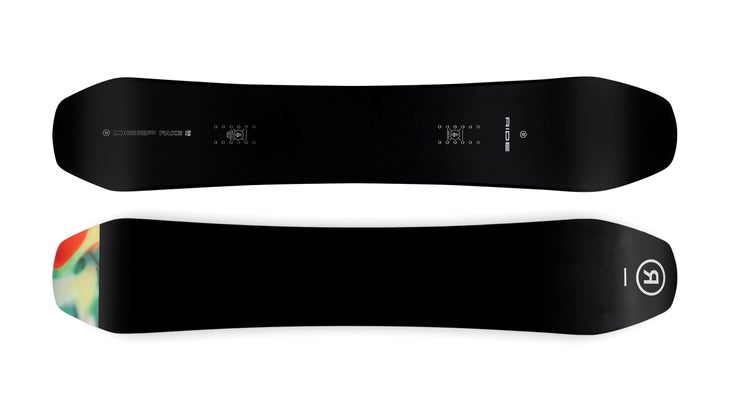
Sizing: 144, 148, 151, 155, 157W, 159, 161W, 162, 165W cm
Genre: All-Mountain/Freeride
Profile: Directional Extra Camber–a camber-heavy hybrid profile
Shape: Directional
Flex: Mid-stiff
Waist Width: 25.2 cm (159 cm)
Sidecut: 10 m (159 cm)
Pros:
- A freeride shape that can float in pow and charge in crud
- Poppy, stompy tail encourages freeriders to lace tricks into their lines
- Titanal-reinforced sidewalls for fast, precise edgework
Cons:
- Not the best switch steed
- Nose is XXL for technical freestyle applications
As soon as Ride’s new unisex freeride machine, the Deep Fake, was unboxed at our snowboard test, a puddle of drool collected at the boots of our test team. Who could blame them? From the murdered-out, matte-black top sheet and the Titanal-lined, ultra-thin sidewalls to the cambered backseat and rockered, beefy nose, riders couldn’t wait to strap into this fresh release. After our crew took the Deep Fake for test drives, that puddle of drool turned into a pond. Safe to say, the new Ride rig lived up to the hype.
Sporting an aspen, bamboo, and paulownia core reinforced with carbon stringers and impact plates at the binding inserts, the Deep Fake is stiff tip-to-tail with a workable torsional flex. The recipe is ideal for chargers who like to spice up freeride lines with natural hits. “It stood up to chunky pow and steep bumps,” reported Zachariah Stein, a born-and-bred Tahoe boarder. “Great maneuverability, but it’s stiff enough for chunky straightlines,” agreed Tahoe Sports Hub snowboard buyer and resident gear nerd, John Lauer. The board’s agility comes courtesy of a relatively narrow waist. Yet the Deep Fake is still buoyant in blower thanks to the robust, rockered nose. Testers also were impressed by the Deep Fake’s Metal Slim Walls, Ride’s newest sidewall tech, which incorporate strips of dampening Titanal into the sidewalls, boosting energy transfer and edge hold. “I loved what they did for performance–the Deep Fake is quick edge to edge,” commented Lauer. Test director Drew Zieff agreed, calling the Deep Fake “reliable on rail, whether you’re maching down a mellow groomer or hop turning down a spicy pitch.”
While a couple of freestyle-oriented ladies voiced a preference for softer, more approachable shapes, hard-charging women were similarly enthralled by the Deep Fake. “It holds an edge and blasts through chunder like a dream,” commented a park-annihilating snowboard coach. “If I didn’t ride park, I’d make this my daily driver for sure.” That last comment sums up the thoughts of both male and female riders of all creeds: the Deep Fake is a charging quiver-killer for some, a freeride board for others, and a look-but-don’t-touch option for beginners, passive intermediates, and jibbers.
Bottom Line: Ride’s new freeride blade is a sharp, floaty, and aggro charger, one that’s well-suited to goosebump-inducing lines, backcountry trickery, and all-mountain raiding of your local resort.
Burton Family Tree Short Stop ($820)
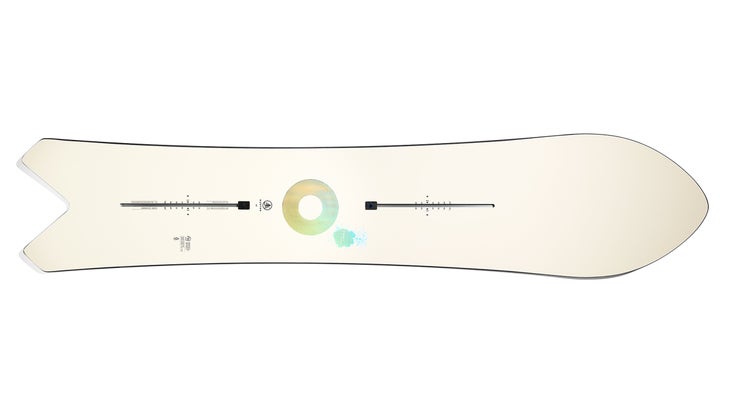
Sizing: 142, 150, 156, 162 cm
Genre: Powder/Freeride
Profile: Flat with a rockered nose
Shape: Directional
Flex: 4-7
Waist Width: 26.5 cm (156 cm)
Sidecut: 7.3 m (156)
Pros:
- Swallowtail shape gives it an edge in deep snow
- Surprisingly versatile
- Carving champion that’s still nimble in trees
Cons:
- Nose is overwhelmed in variable conditions
- Very stable on rail, less so straightlining
If your metric for a good day’s boardin’ is hangtime, high speeds, or harrowing descents, keep shopping. But if it’s ear-to-ear grins and balaclava-blasting powder turns you’re after, the unisex Burton Short Stop might be the lift ticket for your wicket. “I had a smile on my face the whole time I rode this board,” reported tester and snowboard coach Claire Lawrenson after slashing face shot after face shot on a Sugar Bowl powder day.
A new addition to Burton’s continuously stoke-inducing Family Tree line, this swallowtail ranks a touch stiffer and more responsive than the popular, pliable Pow Wrench. But like the Pow Wrench, it’s also volume-shifted, meaning you’ll want to size down compared to your normal snowboard. Lawrenson loved the float provided by the flat-profiled deck, torpedo-like nose, and easily engaged swallowtail in the deep stuff, but she was also impressed by the board’s abilities in marginal conditions, too. “I expected the board to get squirrely in chop, but I was surprised by a responsive ride,” she reported. Another tester loved the Short Stop on groomers and powder, appreciating the euro-carving capabilities and nimble turns afforded by the deep sidecut, but disagreed on the chop front, claiming “chunder and ice made the big nose wobble.” Instead of strapping into the Short Stop and heading straight for the gnar, she recommends riders “set this lady posi-posi and get your turns on.”
Bottom Line: A powder-gobbling swallowtail that’s a consummate carver, too, there’s a spot for the Short Stop in most quivers.
Public Statement ($440)
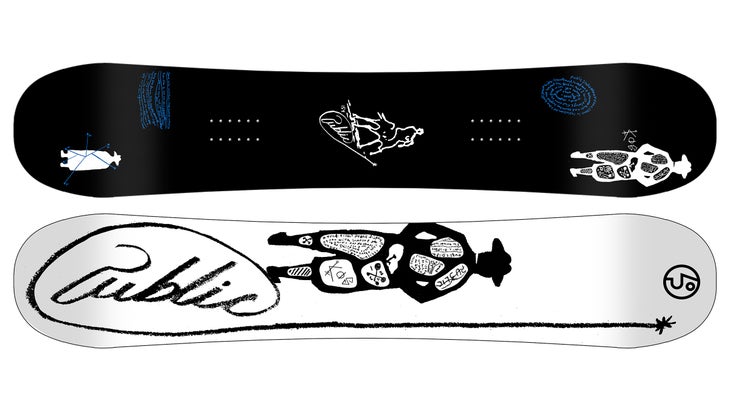
Sizing: 150, 154, 157 cm
Genre: All-Mountain Freestyle/Park/Street
Profile: Camber, with flat sections at contact points
Shape: Twin
Flex: Medium-soft
Waist Width: 25.6 cm (154 cm)
Sidecut: 8 m (154 cm)
Pros:
- For the streets, from the streets, the Public Statement is a gimmick-free, mid-wide freestyle deck ready to demolish steel and concrete
- Trustworthy twin shape rides switch with ease
- Poppy core with carbon reinforcements yields snappy ollies
- Durable build
Cons:
- Locking into presses was challenging for lighter testers
Jonesing for a jib board that can hang in the streets, on jump lines, and at the resort at large? The Public Statement fits the bill. The pro model of Dutch rail royalty Kas Lemmens, the Statement embodies the gimmick-free ethos of Public, a small-scale board builder founded by Minnesota’s own sultan of streets and Hyland Hills heavy-hitter, Joe Sexton. The Statement has payloads of pop thanks to its cambered twin shape, mid-wide waist and an overall middling flex that’s amped up at the contact points with four strips of carbon. “A remarkable combination of soft torsional flex with plenty of pop in the nose and tail makes this deck poppy, stable, and maneuverable,” commented an occasional park rat who was stoked to dust the cobwebs of his rail game on the Statement. “Predictability is a 10/10, inspiring confidence to charge and trick the features you’ve been avoiding all season.” However, it’s worth noting that while aggressive riders were able to lock in to presses, loading those carbon-reinforced zones, lighter riders more accustomed to softer jib boards found the nose and tail on the stiff side.
Bottom Line: Ready for a riotous session at your local rope tow, peak-to-park laps at your home mountain, and a nocturnal mission to that street spot you’ve been scoping for months, the Statement is a freestyle weapon from a brand any bona fide boarder will be stoked to support.
2023 Editor’s Choice: Gnu Barrett ($560)
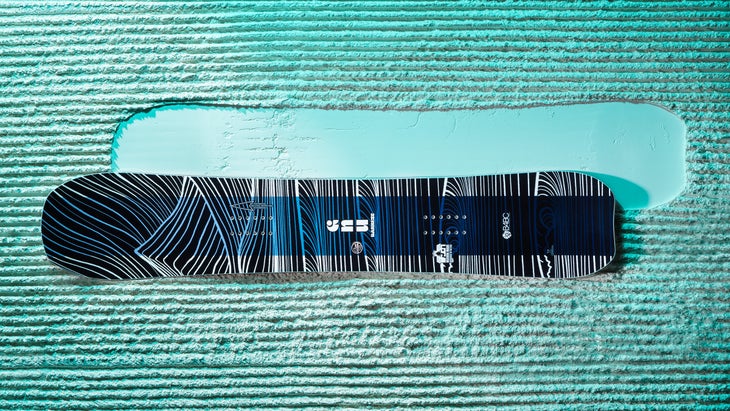
Sizing: 146, 149, 152, 155
Genre: All-Mountain
Profile: C3 Camber
Shape: Directional
Flex: Medium-Firm
Waist Width: 245mm
Pros:
- Top-notch carver
- Can handle most conditions and terrain
- A percentage of proceeds funnel towards Boarding For Breast Cancer
Cons:
- Lighter, jibbier riders had a hard time buttering on this board
- On the deepest days of the test, some riders wanted more float
Once chasing podiums lost its allure, legend Barrett Christy could have slashed off into the sunset. Instead, she maintained pro status and simultaneously accepted a role as a marketing maven and product designer for Mervin, the Washington-based parent company of Lib Tech, Gnu, and Bent Metal. Since 1996, Christy has had her name on an ever-evolving pro model with Gnu, making it the longest-running pro model in women’s snowboarding. The latest iteration, the 2023 Barrett, is a directional all-mountain decimator with a hybrid camber profile and moontail that represents Christy’s currently indiscriminate ambitions: freeride if there’s powder, rip the entire mountain if there isn’t.
A dedicated snowboard nerd, Christy tweaked the Barrett’s sidecut this season, adding Progressive Magne-Traction tech–a spin-off on Mervin’s proprietary serrated, grip-enhancing Magne-Traction edges. “The mag bumps are progressive, so the nose of the board doesn’t have any, and they gradually get more pronounced from the middle of the board to the tail,” she explains. “It’s exactly where I need the edge grip—not at the turn initiation, but at the exit.”
The result was the highest-scoring snowboard of our entire snowboard test by a mile—men’s or women’s. Of the seven women who rode the Barrett during our all-conditions assault at Sugar Bowl, four gave it perfect scores. The rest were just a point shy. Consensus was the combo of a mid-stiff flex, Progressive Magne-Traction, and camber-dominant profile made for a consummate carver. “You want a small turn in tight trees? Check.” said one all-mountain ripper. “Medium turn? Check. Big sweeping groomer turn? Check. Hop turn in a shitty, icy couloir? Check, check, check. I’d ride Ms. Christy’s signature model anywhere.”
The Barrett shone when late-season storms draped Sugar Bowl in multiple feet of powder. “Surfy in pow, as badass as its namesake,” wrote a longtime fan. That said, another rider did crave a little more length on the deepest day (to be fair, we only had the 149 at our test). Freestylers were impressed, too. “Pops like bubble wrap,” lauded a Tahoe park stalwart. A snowboard coach and watercolor artist recommended the board for riders looking to build confidence in their big-mountain riding.
Bottom Line: One-board quiver for freeriders or all-mountain riders who want a directional shape
Read the full review for a more in-depth look at strengths, weaknesses, and tester feedback.
KORUA Transition Finder ($549)

Sizing: 150, 154, 157
Genre: All-Mountain/Freeride
Profile: Float Camber (rockered nose, camber underfoot)
Shape: Directional
Flex: Medium
Waist Width: 25.6 cm (154)
Sidecut: 7.6m (154)
Pros:
- Natural, fluid, rail-to-rail ripper, especially for mid-to-larger-radius turns
- Relatively affordable
- New 150 size opens the unisex board up to lighter, smaller riders
Cons:
- Riding switch is possible but not its strong suit
- Some testers, particularly those who rode the 157, felt overwhelmed when making shorter-radius turns
- We’d love to see more sizes
Korua, a German board builder inspired by Japan’s deep-rooted snow surf culture, mainly crafts directional groomer guns and alternative powder shapes designed to master the subtle art of the turn. The Transition Finder leans more toward traditional all-mountain freestyle applications than the rest of Korua’s lineup, but testers still claimed the board lends itself to on-rail ripping. “Between the camber underfoot, intuitive, easy-entry sidecut, and reliable yet pliable stiffness, the board draws lines like an architect on Adderall,” waxed our surf-inspired test director, Drew Zieff. “Crisp, flawless, not a drop of ink out of place,”
For 2023, Korua shaved the Transition Finder’s nose width, trimming taper back to 18 millimeters from 26 millimeters for the 154-centimeter and 31 millimeters for the 157-centimeter, ensuring that the board isn’t relegated to powder days. The new shape still has a mid-wide, rockered nose that offers ample float—it’s “dreamy yet maneuverable in bottomless snow,” according to one powderhound—but rides switch better than previous iterations. Most testers were pleasantly surprised by a shorter, stiffer tail that enabled the deck to scrub speed, pop spins, and land with unexpected grace. “The best board I’ve tested this week,” wrote Parker Gokey, Sugar Bowl’s Terrain Park Manager, after scoring a pow lap on Mt. Disney’s Donald Duck. On the other hand, a couple of traditionalists felt the notable nose width and shorter tail meant the shape was best reserved for riding regular.
Korua’s standard construction isn’t futuristic but rather damp, solid, and trustworthy. A purposeful lack of marketing, graphics, and frills keeps the price tag attractively low. The unisex board was only available in two sizes (154 and 157 centimeters) last season, but lighter riders will be stoked to learn that a 150 is incoming for 2023. That said, plan to size down a few centimeters. “I ride a 158 all-mountain board normally, and the 154 was money for me,” shared a 5’9”, 150-lb rider, who claimed the medium stiff flex was “approachable, friendly, and workable for intermediates and up.”
Chris Cloyd, a gear-test veteran and guide for High Sierra Snowcat, recognizes that quiver shapes don’t make sense for most riders and saw immense value in the Korua’s versatility. “It’s a 10/10 directional snowboard,” he said. “Camber underfoot, taper and rockered nose for float, edge hold for days, stompablity in pow, playfulness in the park—what more could you ask for?”
Bottom Line: An excellent directional, all-mountain freestyle daily driver for surfier, intermediate and up riders
YES. Rival ($530)

Sizing: 140, 144, 149, 152
Genre: Freestyle/All-Mountain
Profile: Camber
Shape: True Twin
Flex: 6/10
Waist Width: 23.6cm (149)
Sidecut: 7.6/6.2 (149)
Pros:
- Poppy on jumps and pressable on rails
- Capable in most all-mountain situations
Cons:
- Washed out on larger-radius turns
- Mid-Bite can throw off riders accustomed to smoother sidecuts
Between learning tricks and stacking clips, competing and cutting through the noise, up-and-coming pros have their work cut out for them. Luckily, young Canadian style savant Juliette Pelchat partnered with YES to design her dream park workhorse from the ground up. The true twin resonated with our testers from the jump. YES’s “MidBite” sidecut tech, pronounced indents along the edges between the bindings, produces the agility of a narrow-waisted deck while retaining the reliability of a wider board. Factor in a spring-loaded poplar core and you get a freestyle weapon that’s nimble and poppy enough for quick spins and trustworthy enough for high-speed takeoffs and heavy landings. “I would buy this board,” proclaimed snowboard coach Claire Lawrenson. “It’s fun for both the park and for jibbing the mountain like it’s your playground.” Jenna Shlachter, another park regular, was similarly blown away. “The Rival is insanely light,” she said. “It must have secret rockets hiding somewhere because it blasts off anything with minimal effort.” She, too, would swipe plastic on Pelchat’s brainchild—saying she was stoked to find a camber twin rip stick for women that’s flexible enough to press and butter but still has excellent snap and response.
Testers were largely impressed by the Rival’s ability to navigate chop and mix in top-to-bottom resort riding. “It turns on a dime, spins like a dream, floats in pow, and can rail an edge with the best of ‘em—switch and regular,” said Whistler ripper Theresa Clinton. That said, we should mention that a few all-mountain rippers found it washed out on larger-radius, high-speed turns.
Bottom Line: Women’s-specific freestyle board with all-mountain potential
Academy Masters Series ($599)
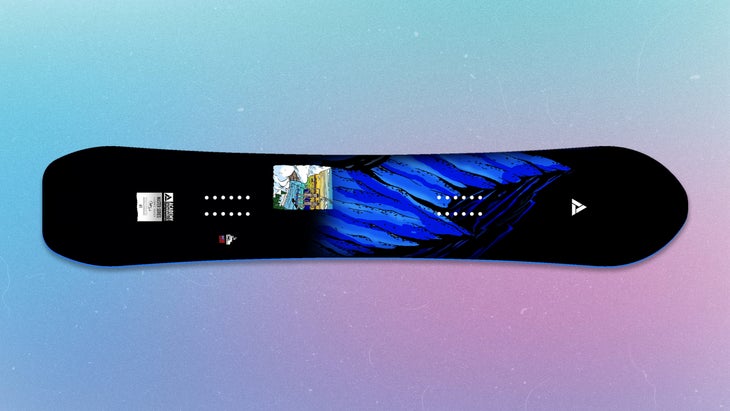
Sizing: 155, 157, 159W, 162W
Genre: Freeride/All-Mountain
Profile: Micro Camber
Flex: 7/10
Waist Width: 25.5 cm (157)
Sidecut: Vario 811
Pros:
- Responsive and stable at speed (multiple testers’ pick to break land speed records)
- Cambered ride for traditionalists
- As durable as they come: unafraid of scratchy, early- or late-season conditions
Cons:
- Tougher to maneuver at slower speeds
- Flex profile limiting for intermediate and under riders
- Durability comes at a price—not the lightest deck we tested
Academy’s Masters Series is refreshingly old school, courtesy of two of snowboarding’s most notable OGs. The directional freeride stick was designed in collaboration with Sierra snowboard legend and style sensei Chris Roach, and sports the traditional camber brand evangelized by Academy co-owner, marquee pro, and king of Colorado, Chad Otterstrom.. This year, Academy added new carbon X’s beneath the inserts. Testers agreed that the resulting mid-high stiffness is a limiting factor for inexperienced riders, but a draw for those who appreciate pop and stability at speed.
Tahoe ripper Armeen Pirooz claimed that the construction inspired confidence when “stomping critical landings and bombing through chunder and traverse tracks.” John Lauer, a longtime tester, snowboard shop buyer, and lighter rider agreed. “This cliff stomper eats chopped run outs for breakfast,” he said. ”The sidecut excels at speed, and has enough nose to cut through pow.” Lauer judged it his favorite board of the test, but echoed the warning: “Not for beginners or early season legs. It does what it’s told, and it’s angry about it. Poppy, powerful, and more capable than you are.”
Riders were also impressed by the build quality. “Between the full-wrap edges, sintered sidewalls and base, and the textured ‘Carbonium’ topsheet, you’ll break yourself before you break this Academy,” said one core shot connoisseur. He also gave the board props on its switch skillset, saying that because many freeride shapes have heavy taper for more float, they can make riding switch feel a little unnatural. But not this board—it has Academy’s all-mountain freestyle roots, and “rides switch better than most of its compatriots.”
Bottom Line: Cambered freeride board for those who like riding fast.
Burton Family Tree 3D Deep Daze ($660)
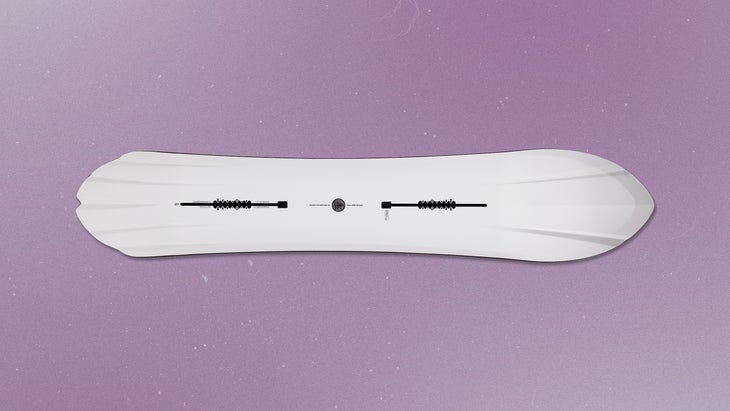
Sizing: 149, 154, 159
Genre: Powder
Profile: Directional Flat Top (Flat underfoot, rockered nose)
Shape: Directional
Flex: Soft
Waist Width: 25.5 cm (154)
Sidecut: 6.2m (154)
Pros:
- Far-out design isn’t a gimmick; delivers energy and float for can’t-stop-smiling surf turns in powder
- More versatile than expected; a few testers applauded groomer performance
Cons:
- Testers were hesitant to push the smaller, softer tail on gnarlier drops
- Short running length and softer flex aren’t ideal for shredding steeper, longer pitches
A recent addition to Burton’s experimental Family Tree line, the 3D Deep Daze is a futuristic deep-snow skiff that riffs on a storied surfboard technology: channels. Channels are hydrodynamic grooves in the bottom of a surfboard that purposefully funnel water, assisting with speed generation and purchase. If you want to nerd out, dive into this interview with legendary …Lost Surfboards shaper Matt Biolos. Now, three-dimensional bases aren’t rare in snowboarding—brands like Bataleon, Burton, Morrow, and more have been experimenting with this tech for years–but channeled bases have typically been reserved for chasing barrels, not blower. That said, shapers of powsurfers—boards meant to be ridden without bindings in untouched powder—like Grassroots and Äsmo have been bringing channel tech to snow, as the dynamics of powder and water aren’t so different. The Deep Daze isn’t a powsurfer—it’s meant to be ridden with bindings—but it gives traditional snowboarders a chance to get tubed when the forecast is firing.
“Even though I’ve ridden plenty of contoured bases, I’d never tried anything like that,” reported a still-reeling tester after riding the Deep Daze on the deepest days of our test.
He claimed the channels produced “surfy drive and energy through turns.” Add to that a flat base, rockered nose, and mid-soft flex, and the 3D Deep Daze “pumped, bounced, and buttered through powder like a peyote-popping porpoise on a vision quest.” Testers were astounded by the balance of nimbleness and float of the 154, which has a relatively wide 30.5-centimeter nose, two centimeters of taper, a fairly narrow 25.5-centimeter waist, and a tight 6.2-meter sidecut radius. “I have no problem riding a 25.5-cm-waisted board in deep snow, but I’d expect the length to be closer to my normal freeride specs of 158 to 160,” said our incredulous tester. “If you told me that I’d have some of my most memorable powder turns of the year on a flat-based 154 with a 25.5-cm waist and a 100-centimeter running length, I’d have called you crazy.”
Thanks to an alchemical amalgamation of flex, specs, and a dash of borrowed surf tech, the Deep Daze threaded trees like yarn bombers. But freeriders who preferred firmer equipment for high-speed big mountain riding dubbed it a specialized board best saved for powder days. “Too soft,” said one. “In specific conditions, this board will blow your mind. Think Hokkaido, Japan.” On the other hand, riders used to softer sticks gave the shape more credit. “I was pleasantly surprised,” wrote jibby snowboard instructor Case Gergen. “It carves smoothly on groomers and the channels make riding powder effortless. I liked riding this in all conditions.” Meanwhile, Alec Sullivan, a Sugar Bowl park crew member said it was “Exactly the playful-to-control ratio I like.”
Bottom line: A perfect board for pow-chasing trips to Baldface or Hokkaido
How to Buy
Shopping for snowboards is like dropping a cliff: It’s equal parts exciting and nerve-wracking. But if you do your homework before you send, chances are you’ll ride out just fine. Here are a few tips to help you stick your landing:
Ride as Many Boards as Possible
Demo boards, swap with your friends, and do whatever it takes to ride as many boards as you can. Engaging with a diverse range of boards will expand your snowboard lexicon. You can read reviews all day long, but nothing informs your decision-making like time on snow. If you’re relatively new to the game, experimenting is especially important: you’re still developing your preferences, and riding more boards will speed up that process. If you’re an old head who’s been riding the same style of board for decades, don’t be afraid to break out of your shell and try something new. The exception is complete newbies, as switching boards before you know how to turn properly may only frustrate you. Get a board that works, stick with it, and postpone demo sprees until you can comfortably tackle intermediate and advanced terrain.
Shop By Riding Style
Here are the three most common board styles:
Park Boards: Park boards are on the shorter side, which makes them easier to spin. They’re often true twins, meaning they’re symmetrical from nose to tail, facilitating landing and riding switch. Directional twins are also common: These boards are symmetrical in shape but not in flex pattern or profile, or vice versa. Some park boards are softer, allowing riders to flex, press, and butter, while others are stiffer to handle heavy landings and hold an edge in halfpipes.
Freeride Boards: Freeride boards are designed for speed and stability when charging groomers, riding off-piste, and ripping backcountry conditions. They’re usually directional (the nose and tail are defined) and tapered (the nose is wider than the tail). Directional shapes float and carve well but riding switch isn’t a cakewalk. Many freeride boards are also stiffer, supplying stability for big mountain charging, while others are soft for cruising mellow powder.
All-Mountain Boards: All-mountain shapes blend the freestyle elements of park boards and the big-mountain chops of freeride decks. They’re meant to be ridden, as the name suggests, all over the mountain–they can ride switch through the park one lap and bomb a hike-to chute the next. If you’re unsure of where to start or you only have a budget for one board, go with a versatile all-mountain board. These shapes are usually directional or directional twins.
Profile
Profile refers to the curvature that’s visible when you lay a board flat on the ground and look at it from the side. It is a critical element of board design, as it dictates how and where a board interacts with snow. There are two primary profiles to be familiar with.
Camber: Camber is the time-honored, traditional profile. Lay a cambered board flat, and it looks like an upside-down U. The board will touch the ground near the nose and tail, but the center will be raised. This curvature supplies drive, stability, and edge hold–it allows riders to flex into the deck and dig into the snow. It’s also a principle ingredient in pop production—if you like to send ollies to the moon or carve aggressively on groomers, camber is your launch pad.
Rocker: Rocker is reversed camber. Lay a rockered board flat, and it’s shaped like a U. You’ll find a single low point in the center of the board while the nose and tail float off the ground. Rocker provides a fun, skatey ride. It’s easy to turn, and enables you to weight your back foot and float through deep powder. However, it’s not as reliable in technical steeps, on icy hardpack, or on high-speed straight lines.
Hybrid Camber: Hybrid profiles mix rocker and camber. These combos usually attempt to blend the skatey, buoyant, easy-turning aspects of rocker with the pop, stability, and edge-hold of camber.
Sizing Tips
Sizing a board can be just as tricky as picking one in the first place. Sizing depends on a number of factors, both in terms of the board itself and the rider who’s rocking it. Here are a few to keep in mind.
Board Length and Rider Height: Back in the day, length was the primary measurement taken into account when sizing a board. You’d walk into a shop, a stoned teenager would hold a board up to see if it reached between your chin and nose, and bingo: you were on your way. But this outdated method doesn’t account for weight, which is arguably a more important data point. Nor does it touch on board width, as wider shapes are more common these days.
Rider Weight: Weight, more so than height, is what enables a rider to flex a board and engage its camber profile. Many brands’ size charts don’t mention height but do include rider weight ranges. This is a solid place to start.
Skill Level: If you’re a beginner, look at softer, forgiving shapes—and if you’re between sizes, err shorter. For example, if you weigh 170 pounds and you’re deciding between a 157-centimeter option that’s recommended for 120-180 pounds and a 159 that’s recommended for 140-200 pounds, go with the 157. A smaller board is going to be much easier to turn and better suited for learning. If you’re an intermediate, size in the middle of your weight range and consider slightly stiffer all-mountain shapes–these boards will allow you to progress and build upon the skills you developed on a softer, shorter shape. If you’re an advanced rider, your board sizing depends more on riding style.
Riding Style: As we mentioned earlier, different boards are meant for different objectives. Rail riders like small, easy-to-spin boards, while freeriders appreciate the stability of a longer effective edge when speeding down big mountain lines. If you ride everything, a complete dream quiver might look like this: 152 rail board, 155 park board, 158 all-mountain board, 160 freeride board, 161 powder board. That said, we recognize most people can’t afford a full quiver. So, when in doubt, go with an all-mountain shape and size to get the most versatility for your buck. That 158 can still hit jumps and rails, and on powder days, you can set back your bindings for more float.
Snow Conditions: Powder-specific boards are usually longer, wider, or both, providing more surface area and float in deep snow. If you frequent a powder-blessed location like Japan, you’ll want to size up. If you live on the east coast, that might not be necessary.
Boots: If you have large boots, particularly in relation to your height and weight, you may need to consider a mid-wide or wide board. The last thing you want is toe or heel drag, which will happen on a board that’s too narrow for your boot length.
Volume-Shifted Shapes: Some boards, referred to as volume-shifted shapes, are meant to be ridden shorter than traditional snowboards. Volume-shifted shapes condense the surface area and float of a longer shape into a more maneuverable package. Usually, a brand will supply sizing recommendations for volume-shifted shapes. Once you figure out your standard board sizing—like the 158 all-mountain shape we discussed above—you’ll be able to size volume-shifted shapes accordingly.
Demo Multiple Sizes: Again, the best way to develop your understanding of snowboard sizes is to keep demoing boards. Don’t just demo different boards from different brands, either—if possible, demo the same board, from the same brand, in slightly different sizes, and test them in varied conditions.
